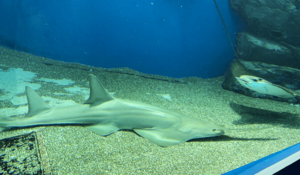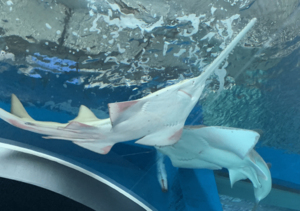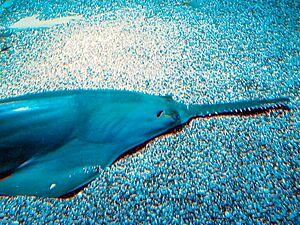Dwarf sawfish facts for kids
Quick facts for kids Dwarf sawfish |
|
|---|---|
 |
|
 |
|
| Pristis clavata in the Maxell Aqua Park Shinagawa | |
| Conservation status | |
| Scientific classification |
The dwarf sawfish, also called the Queensland sawfish, is a special type of sawfish. Its scientific name is Pristis clavata. You can find it in the warm waters of northern Australia. This sawfish is the smallest in its family, and it's an endangered species, meaning it's in danger of disappearing.
Contents
What They Look Like
The dwarf sawfish has a body shaped like a torpedo, much like a shark. It can grow to be about 3.2 meters (10.5 feet) long. It has wide, triangle-shaped fins on its sides and big, tall fins on its back. The first back fin is usually right above or a little behind its belly fins. Its tail fin has a very small lower part.
The front of its head is wide and flat. It stretches out into a long, flat snout called a rostrum. This rostrum has about twenty pairs of teeth-like spikes along its edges. The dwarf sawfish is usually greenish-brown or sometimes yellowish-brown on top, and whitish underneath.
Where They Live
The dwarf sawfish originally lived in a much larger area, including the western and central Indo-Pacific region. Today, you can mainly find them from southern New Guinea to the tropical parts of northern Australia. They usually live in waters close to the shore, in river mouths (estuaries), and in muddy areas that are covered by tides. Sometimes, they even swim into the lowest parts of rivers.
How They Live
This sawfish mostly eats fish, but it also enjoys eating shellfish and crabs. Its long snout (rostrum) has many tiny holes that can sense electricity. This helps the sawfish find food, especially in the muddy water where it often lives. The rostrum might also be used to move its prey around.
Even though they are sometimes found in deep water, dwarf sawfish usually move around when the tide is coming in or going out. During each tide cycle, they can travel up to 10 kilometers (6 miles). When the tide is high, they often look for food and rest among the mangrove trees.
Life Cycle and Babies
We don't know a lot about how dwarf sawfish have their babies. They are ovoviviparous. This means the babies grow inside eggs inside the mother's body, and they get their food from the egg yolk. The babies hatch inside the mother and then swim out.
It's not known how many babies a mother sawfish can have at one time, or how often they can have them. When the young are born, they are about 65 centimeters (26 inches) long. Scientists think that dwarf sawfish can live for up to 48 years.
Why They Are Endangered
The dwarf sawfish is a protected animal in Australian waters. However, in other parts of the world, sawfish are caught for their meat, fins, snouts, and oil. The biggest danger to the dwarf sawfish is getting caught by accident in fishing nets, like gillnets and trawl nets. This is called "bycatch."
The fact that their numbers are dropping fastest in areas with a lot of fishing shows that bycatch is a big problem. The International Union for Conservation of Nature says that this fish is "critically endangered". This means it's at a very high risk of disappearing forever.
There's a need to teach fishermen how to safely release sawfish if they catch them by accident. They also need to learn how to manage their fishing better. Sadly, the dangers to the dwarf sawfish are still happening, and their numbers are not getting better.
Because there are so few dwarf sawfish left, they are rarely kept in aquariums. As of 2021, only two dwarf sawfish (one male and one female) are living in a public aquarium in Japan called Aqua Park Shinagawa.
See also




